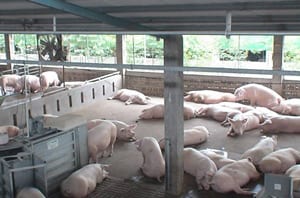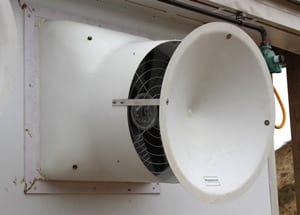Maintaining a minimum ventilation rate for barns and other livestock housing is an important factor in improving productivity and thus, profitability, of farming operations. Animals within a confined building must have ventilation, either through natural or mechanical means, or by a combination of the two methods. Livestock productivity is linked to and influenced by the animal’s environment. Proper ventilation of barns or pens not only improves air quality, but air movement aids in eliminating gases, odors and moisture, and replenishes it with fresh air that is necessary for livestock production.
Why is Proper Ventilation Important?
 Adequate ventilation is especially needed in temperate climate zones. Barns must have a sufficient ventilation flow where extended periods of high and low ambient temperatures and relative humidity fluctuate with the seasons. This includes much of the United States and Europe. A well-designed ventilation system can effectively reduce moisture condensation and dampness in barns during winter, and heat and humidity during the summer months.
Adequate ventilation is especially needed in temperate climate zones. Barns must have a sufficient ventilation flow where extended periods of high and low ambient temperatures and relative humidity fluctuate with the seasons. This includes much of the United States and Europe. A well-designed ventilation system can effectively reduce moisture condensation and dampness in barns during winter, and heat and humidity during the summer months.
The minimum ventilation rate in a barn or pen should remove the dampness and moisture generated by livestock, but preserve as much of the heat generated as possible during the winter. The air exchange is also important in removing harmful gases produced by the animals such as ammonia, hydrogen sulfide, and methane, which can be detrimental to the health of both animal and farm operators. At all times, appropriate temperature and humidity must be maintained for the health and performance of the livestock.
How to Calculate Minimum Ventilation Rate
The minimum ventilation rate of a barn must provide an acceptable thermal and aerial environment for the animals. Determining that minimum ventilation rate in large part relates to:
- Size of the structure
- Kind of animals
- Number of animals
For example, the ventilation requirements for pigs are different than those of other livestock. To achieve the minimum ventilation rate for a pen, the exhaust fans must be able to pull the stale air created by a growing pig that can produce an average of 7 grams of water vapor an hour multiplied by the size of the herd occupying that space.
Is Passive Ventilation Enough?
Ventilation is a necessity, if not an imperative. Natural or passive ventilation circulates air through openings in a building without any mechanical means. It relies on natural wind flow outside the building to circulate the air inside and then out of the building. Because air exchange can fluctuate with the temperature, wind conditions and weather, passive ventilation may not be that adequate to achieve minimum ventilation rate. The oxygen supply in buildings needs to be replenished with drier, ambient air from outside. As a method, it must work in combination with some type of mechanical ventilation.
How to Achieve Proper Ventilation
Mechanical ventilation is necessary to replenish the fresh air supply to a building and remove the foul air. Livestock ventilation systems combine a combination of fans blowing air out of buildings with ceiling, wall, and hallway inlets and roof cupolas. This provides proper ventilation and aids in keeping indoor environments clean and healthy.
 In any ventilation system, air temperature and aerial movement must be controlled, such as housing for animals that are sensitive to cold, sudden changes in temperature, and drafty conditions. Mechanical ventilation is a common method to achieve minimum ventilation rate. It provides improved control over temperature and air exchange within the barn. In most climates, successful farm operations could require some mechanical ventilation and supplemental heating like heating pads to keep the animals sufficiently warm.
In any ventilation system, air temperature and aerial movement must be controlled, such as housing for animals that are sensitive to cold, sudden changes in temperature, and drafty conditions. Mechanical ventilation is a common method to achieve minimum ventilation rate. It provides improved control over temperature and air exchange within the barn. In most climates, successful farm operations could require some mechanical ventilation and supplemental heating like heating pads to keep the animals sufficiently warm.
Whether renovating or improving an existing ventilation system, an integrated combination of exhaust fans, fresh air inlets, circulation fans, and controls to match the size of the building and the animals you manage will enable your farm operation to achieve the minimum ventilation rate as needed.





